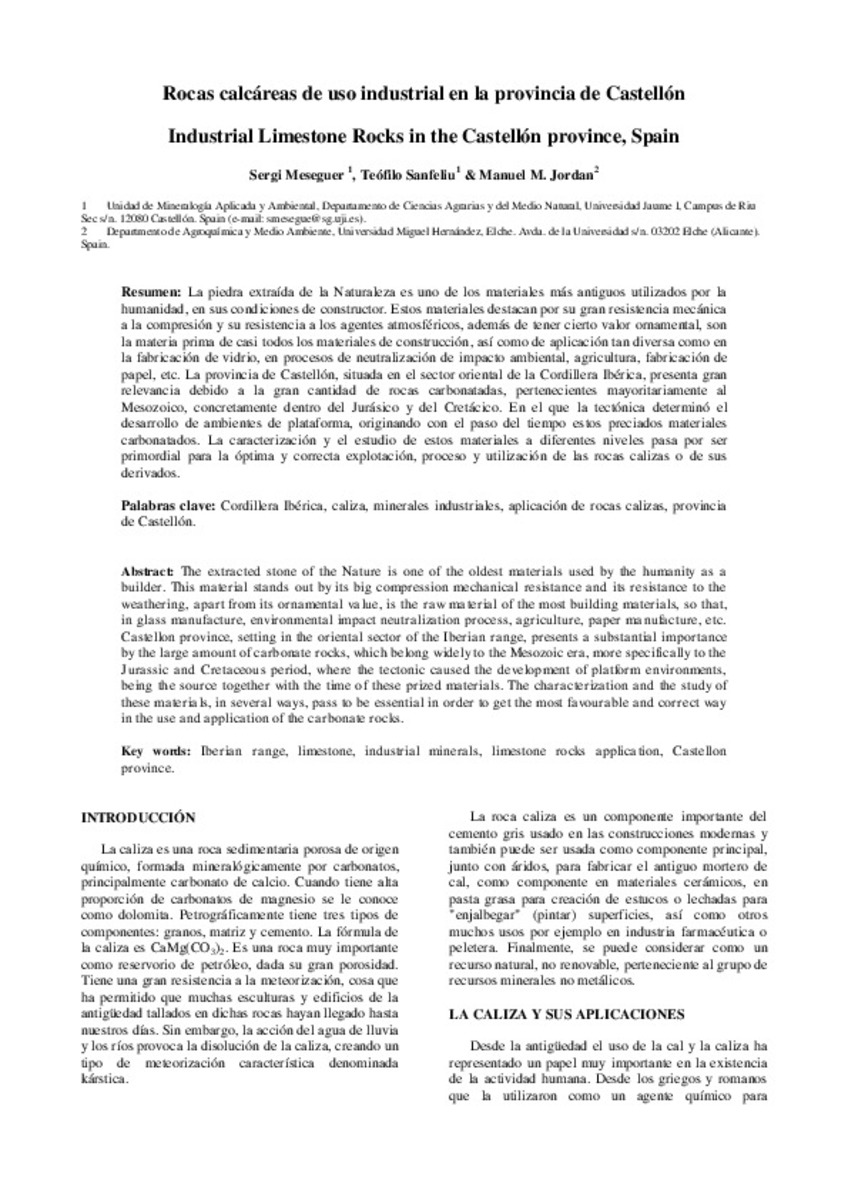Mostrar el registro sencillo del ítem
Rocas calcáreas de uso industrial en la provincia de Castellón
| dc.contributor.author | Meseguer Costa, Sergio | |
| dc.contributor.author | Sanfeliu Montolio, Teófilo | |
| dc.contributor.author | Jordán Vidal, Manuel Miguel | |
| dc.date.accessioned | 2011-05-16T11:00:13Z | |
| dc.date.available | 2011-05-16T11:00:13Z | |
| dc.date.issued | 2008 | |
| dc.identifier.citation | MESEGUER COSTA, Sergio; SANFELIU MONTOLIO, Teófilo; JORDÁN VIDAL, Manuel Miguel. Rocas calcáreas de uso industrial en la provincia de Castellón. Geo-temas, 2008, v,. 10, p. 1163-1166 | |
| dc.identifier.issn | 1567-5172 | |
| dc.identifier.uri | http://hdl.handle.net/10234/22347 | |
| dc.description.abstract | The extracted stone of the Nature is one of the oldest materials used by the humanity as a builder. This material stands out by its big compression mechanical resistance and its resistance to the weathering, apart from its ornamental value, is the raw material of the most building materials, so that, in glass manufacture, environmental impact neutralization process, agriculture, paper manufacture, etc. Castellon province, setting in the oriental sector of the Iberian range, presents a substantial importance by the large amount of carbonate rocks, which belong widely to the Mesozoic era, more specifically to the Jurassic and Cretaceous period, where the tectonic caused the development of platform environments, being the source together with the time of these prized materials. The characterization and the study of these materials, in several ways, pass to be essential in order to get the most favourable and correct way in the use and application of the carbonate rocks | ca_CA |
| dc.description.abstract | La piedra extraída de la Naturaleza es uno de los materiales más antiguos utilizados por la humanidad, en sus condiciones de constructor. Estos materiales destacan por su gran resistencia mecánica a la compresión y su resistencia a los agentes atmosféricos, además de tener cierto valor ornamental, son la materia prima de casi todos los materiales de construcción, así como de aplicación tan diversa como en la fabricación de vidrio, en procesos de neutralización de impacto ambiental, agricultura, fabricación de papel, etc. La provincia de Castellón, situada en el sector oriental de la Cordillera Ibérica, presenta gran relevancia debido a la gran cantidad de rocas carbonatadas, pertenecientes mayoritariamente al Mesozoico, concretamente dentro del Jurásico y del Cretácico. En el que la tectónica determinó el desarrollo de ambientes de plataforma, originando con el paso del tiempo estos preciados materiales carbonatados. La caracterización y el estudio de estos materiales a diferentes niveles pasa por ser primordial para la óptima y correcta explotación, proceso y utilización de las rocas calizas o de sus derivados | |
| dc.format.extent | 4 p. | |
| dc.language.iso | spa | ca_CA |
| dc.publisher | Sociedad Geológica de España | ca_CA |
| dc.relation.isPartOf | Geo-temas, 2008, v. 10, | |
| dc.rights | © Sergi Meseguer | |
| dc.rights.uri | http://rightsstatements.org/vocab/InC/1.0/ | * |
| dc.subject | Iberian range | ca_CA |
| dc.subject | Limestone | ca_CA |
| dc.subject | Industrial minerals | ca_CA |
| dc.subject | Limestone rocks application | ca_CA |
| dc.subject | Castellon province | ca_CA |
| dc.subject | Cordillera Ibérica | |
| dc.subject | Caliza | |
| dc.subject | Minerales industriales | |
| dc.subject | Aplicación de rocas calizas | |
| dc.subject | Provincia de Castellón | |
| dc.title | Rocas calcáreas de uso industrial en la provincia de Castellón | ca_CA |
| dc.title.alternative | Industrial Limestone Rocks in the Castellón province, Spain | ca_CA |
| dc.type | info:eu-repo/semantics/article | ca_CA |
| dc.rights.accessRights | info:eu-repo/semantics/openAccess |







